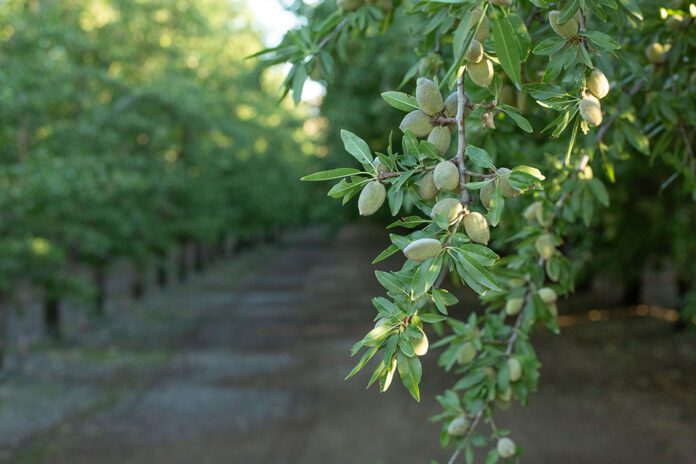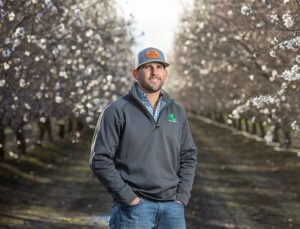
In a Nutshell: Listen to the Summary
As California tree nut growers face mounting pressure to conserve water and comply with evolving regulations, effective irrigation management has become central to long-term orchard success, especially during the early years. Young trees, with still-developing root systems, require consistent and well-timed moisture to establish a strong foundation and avoid stress-related setbacks that can impact future productivity.
When irrigation is closely aligned with nutrient delivery and soil conditions, growers can better support healthy root development, prevent deficiencies and set the stage for decades of strong yields. Early decisions about water and nutrient management are critical to building a resilient, efficient orchard system.
Mae Culumber, UCCE orchard crops advisor in Fresno County, was among several farm advisors who recently spoke at a workshop on irrigation in young orchards. She noted that irrigation and nutrient planning are often approached as separate strategies, but that mindset may miss the mark.
Culumber said that while irrigation and nutrient management are often thought of separately, they are frequently connected through fertigation. Because of this, she stresses the importance of understanding how water movement affects nutrient uptake, especially nitrogen.
“The nutrients are going to go where the water goes,” she said. “If we’re pushing water past the effective root zone where 90% of the roots are, then those nutrients are not going to be accessible for uptake.”
For young trees, irrigation systems must be designed with root development and soil variability in mind. Tobias Oker, UCCE advisor in Kern County, noted that irrigation efficiency begins with understanding a soil’s water holding capacity.
“Plants extract water from the top half of the root zone,” Oker explained. “So, if you’re pushing water past the effective root zone where 90% of the roots are, then those nutrients are not going to be accessible.”
Cameron Zuber, orchard crops advisor in Merced County, emphasized the importance of estimating evapotranspiration (ET) and adjusting for young trees.
“ET reports are usually for mature trees,” he said. “You can adjust for young trees using canopy coverage or a percentage of full ET.”
For example, growers can use a rule of thumb of 0.4 to 0.75 adjustment factor for almond trees aged one to three years. Zuber recommended spoon-feeding irrigation and checking assumptions with soil moisture sensors or by monitoring plant water stress.
“Determine the amount, irrigate that amount and check that it was right,” he said.

Matching Nutrients to Growth Stage and Soil Conditions
Outlining the key drivers of nutrient availability, Culumber noted that soil texture, pH, organic matter and irrigation timing all play a role.
“Soil pH is extremely critical, particularly with micronutrients,” she said. “We have higher pH soils, and those nutrients may be in the soil, but because of different chemical interactions, they may not be available.”
N remains a primary nutrient of concern in young orchards. Culumber shared CDFA’s fertilizer guidelines and explained that N requirements include not just the yield-driven demand but also vegetative growth.
“With young bearing orchards, you’re going to be anywhere between probably 10 and 40 pounds extra nitrogen per year to account for that vegetative growth need,” she said.
But she warned a critical mistake would be applying too much N too early in the season.
“If you’re applying a large amount early and the trees aren’t actively taking a lot of it from the soil yet, that N can leach below the root zone during subsequent irrigations.”
Timing Is Key for Spoon-Feeding Fertilizer
Phoebe Gordon, UCCE orchard crops advisor in Madera and Merced counties, has conducted multi-year studies on pistachio fertilization. Her findings suggest that young pistachios do not respond significantly to N or phosphorus in the first couple of years.
“We found much higher rates of N left in the soil in the 2 ounces and 4 ounces per tree compared to our lower rates,” she reported.
Despite applying different N rates, Gordon observed no significant difference in tree growth across three different sites.
“To me, that indicates the innate demand of pistachios might just be less than something like almonds,” she said.
One possible reason may be that pistachios invest more in root growth than top growth in their early years.
“Pistachios put a lot of their biomass into the rooting system,” Gordon said. “They’re really good at picking up N deep in the soil.”

Design Considerations for Irrigation Systems
Choosing the right irrigation system is also crucial during orchard establishment. Moneim Mohamed, UCCE irrigation and soils advisor in San Joaquin, Stanislaus and Merced counties, suggested designing systems that apply water directly to the root zone while minimizing evaporation and runoff. He also stressed the need for variable-rate irrigation systems in fields with diverse soil types.
“In the SGMA era, you won’t have the luxury of wasting water,” he said. “Consider installing systems that let you irrigate sandy and clay areas separately.”
If you need to protect your orchard from frost, Mohamed recommends using mini sprinklers. Just keep in mind that they lose more water to evaporation than drip systems.
“For first- and second-leaf irrigation systems, button drip emitters are the best option. You can block the button drip emitter and install microsprinklers as the trees get larger,” he said.
Monitoring and Adapting Management Plans
Throughout the workshop, advisors urged growers to validate their plans with real-time data. Zuber said growers should pick the best tool for their operation.
“Whether it’s soil moisture probes, pressure chambers or visual cues, it needs to fit into your system and routine,” he said.
Echoing the sentiment, Culumber said growers can’t manage what they don’t measure.
“Use leaf and soil samples consistently to make midseason adjustments,” she said.
The Role of Foliar Nutrition in Young Orchards
In addition to UCCE research, industry experts in crop nutrition note that foliar fertilizers can complement early irrigation and fertility strategies. While most young orchard fertility programs rely primarily on soil-applied inputs, foliar nutrition can serve as an effective tool, particularly when root systems are still developing and nutrient uptake may be limited.
Dylan Rogers, sales account manager with AgroLiquid, a crop nutrition company specializing in high-efficiency liquid fertilizers, said that in the first couple of years, root mass is both limited and sensitive.
“You can get carried away through the soil and burn up roots,” he said. “So, relying on a little bit of foliar fertilizer is definitely an option.”
Foliar feeding is especially helpful for micronutrients like zinc, manganese and iron, which are often harder for developing trees to mine from the soil. Zn in particular is in high demand for almonds and other tree nut crops.
“Even a full-size mature tree is limited on mining some of these micronutrients out of the soil,” Rogers said.
Timing foliar applications for when trees reach full leaf-out ensures better absorption and allows growers to get ahead of deficiencies, Rogers explained.
“It’s a good opportunity to get some of these micronutrients on early season to set them up for success for the growing season,” he said, adding that later-season tissue sampling can help fine-tune the program, especially if a second application is needed before fall leaf drop.
As with all inputs, balance is key. Growers should weigh foliar feeding alongside soil test data, fertigation plans and tissue results to avoid
overapplication.
Rogers said it’s crucial to have a game plan going into the season.
“Take that soil sample and make sure you’re pulling those tissue samples so that you can adjust that game plan,” he said. “That’s probably the most important takeaway.”
With summer heat looming, Rogers also reminds growers that potassium and calcium are important tools to protect crops.
“Potassium is really important in heat stress mitigation, controlling the opening and closing of the stomata and plant respiration,” he said. “Calcium helps with cell structure, and micronutrients like manganese, iron and zinc support photosynthesis and cellular processes.”

Kristin Platts | Digital Content Editor and Social Correspondence
Kristin Platts is a multimedia journalist and digital content writer with a B.A. in Creative Media from California State University, Stanislaus. She produces stories on California agriculture through video, podcasts, and digital articles, and provides in-depth reporting on tree nuts, pest management, and crop production for West Coast Nut magazine. Based in Modesto, California, Kristin is passionate about sharing field-driven insights and connecting growers with trusted information.















